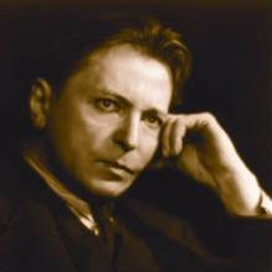GEORGE ENESCU (1881-1955)
Born 19 August 1881 in a relatively small village of Liveni-Vârnav (today Dorohoi) in Moldavia, the eastern region of Romania. He was the youngest of eight children and the only one to survive infancy. His father, Costache, was an estate bailiff, and his mother, Maria, a school teacher who loved music and often played the piano. Young George showed signs of exceptional musical talent from the age of 3 or 4. He greatly enjoyed the folk songs and dances of his fatherland. His first known composition is dated 1887.
After some piano lessons with his mother, Enescu was sent to a famous Roma violinist, Niculae Chioru, who taught him the instrument. Soon it became evident the little Enescu required more advanced training, so his father sent him to Iaşi, the Moldavian 'capital', where studied with Edouard Caudella. With Caudella's recommendation Enescu arrived to Vienna in 1888, and the Conservatory made an exception to the general admission rule and took Enescu although he was only 6. There he studied with Josef Hellmesberger Jr., Robert Fuchs and Johann Nepomuk Fuchs. He meets Brahms and plays first violin under him in a student orchestra. He attends the Viennese Opera where Hans Richter conducts Wagner, whose music leaves a deep impression and a long-lastin influence on young George. On 15 July 1893 Enescu graduates with top marks, and gives a concert in the Musikvereinssaal. After further two years of studying with Fuchs, he leaves for Paris and enters the Paris Conservatory.
There his teachers are Massenet, Fauré and Gédalge, while his fellow students include Ravel and Koechlin. Massenet speaks very highly of Enescu. In 1898, Enescu being 16, the premiere of his first orchestral work, Poeme Roumaine, takes place in Paris. The audience is dumbstruck. In the same year, Enescu conducts the Poeme, for the first time in his life, in the Ateneul Român hall in Bucharest.
To shorten this long post:
- 1899 - graduates from the Paris Conservatory - awarded with a Bernardel violin
- 1900 - starts giving violin lessons in Bucharest - gives public recitals - composes his
Octet for Strings - meets Queen Elizabeth of Romania (Carmen Sylva)
- 1901-1902 - composes the
Romanian Rhapsodies
- 1902 - becomes a member of the Society of French Composers
- 1904 - becomes a member of the examination commission of the Paris Conservatory
- 1903 -
First Orchestral Suite (the 1st movement is sometimes as bold harmonically as Messiaen)
- 1905 -
Symphony No.1- 1914 - stays in Romania - conducts the premiere of Beethoven's 9th in Romania -
Symphony No.2 and Second Suite - raises funds for the building of an opera house in Bucharest and to supply the Ateneul with an organ (contributes generously himself)
- 1916 - becomes a member of the Romanian Academy - during the occupation of Muntenia and Bucharest, stays in Iaşi, and founds the Iaşi Philaharmonic Orchestra
- 1920 - made president of the Society of Romanian Composers
- the 20s - constantly travels between Paris and Bucharest, gives unforgettable performances of Bach and Chausson - Menuhin becomes his student
- the 30s - travels to the USA for concert tours - teaches violin on Harvard
- 1932 - Enescu in Paris for the French premiere of Elgar's Violin Concerto, played by Menuhin and conducted by Elgar himself
- 1936 - the premiere of Enescu's opera
Oedipe - plays his Violin Sonata No.3 with Dinu Lipatti
- 1939 - marries Maria Cantacuzino-Rosetti - lives in Bucharest
- 1946 - due to the establishment of communism in Romania, leaves for the USA
- 1948 - gives masterclasses in New York
- 1955 - dies in Paris, 4 May - interred at the famous Pere Lachaise cemetery
Enescu and young Menuhin
Enescu's childhood house
http://www.editionsilvertrust.com/enescu-octet.htm
- sample bites of the Octet (I love the opening of the work and the Tres fougueux!)










